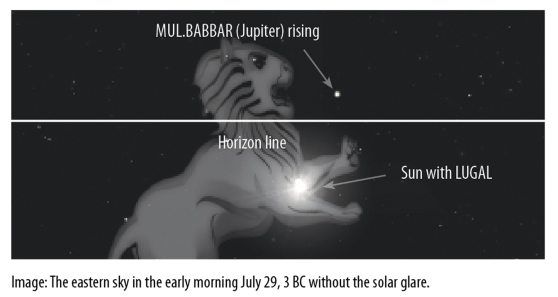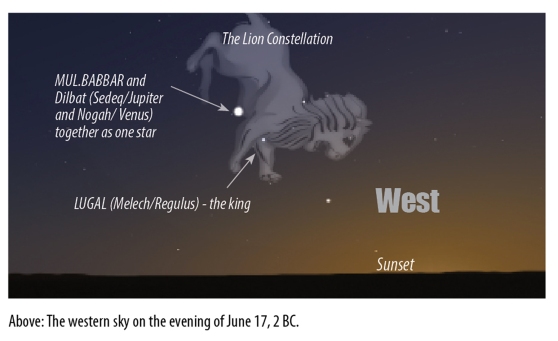These events on this page preceded the arrival of the Magi in Judaea. This series of events involving the star was part of the reason that the wise men were so confident that the Messiah had been born. There are possibly 12 to 13 signs involving the star before the arrival of the Magi in Judaea. Other secondary signs were also involved.
MUL.BABBAR (Sedeq/Jupiter) was in the lion constellation in 3/2 BC. It was often involved with LUGAL / Melech (Regulus) and the Sun and Moon in symbolic events during that period.
The four examples below are part of the series of 12 or 13 principal signs. The entire series of events must have given immense confidence to the wise men. Therefore they could say without hesitation on arriving in Jerusalem “Where is he who has been born king of the Jews.
All four of these signs involve the sun or moon in relation to the principal “star” MUL.BABBAR (Sedeq/Jupiter). This seems to be connected to the promise in the Psalms concerning the sun and moon as witnesses of the enduring nature of the Messiah’s throne.
“His descendants shall endure forever, and his throne as the sun before Me.
“It shall be established forever like the moon, and the witness in the sky is faithful.” (Psalm 89:36-37)
Some of the Celestial Events
Sample Event 1
MULBABBAR’s (Jupiter/Sedeq) heliacal rising probably happened on July 29 in 3 BC. On this same day, the sun was in conjunction with Regulus, the king star in the constellation of Leo (the lion). For several reasons MUL.BABBARS’s heliacal rising would have not been visible when the sun was in conjunction with Regulus before the first century BC. The ancients were well aware of the position of the sun in relation to the background stars. The first visibilities of stars and planets were always predicted, observed and noted by the Babylonians. The symbolism related to messianic kingship is evident especially if one thinks of Psalm 89 and Genesis 49.


Sample Event 2
On November 26/27 in 3 BC MULBABBAR / Tzedek (Jupiter) reached its first stopping point in its regular cycle. At this exact time, the moon passed in front of Regulus (LUGAL / Melech), the king star (an occultation). The combination of the stopping point and the occultation together is exceedingly rare. It can only take place once in approximately 5,500 years. The symbolism is evident. The king star Regulus is being highlighted by the moon while MUL.BABBAR (Jupiter/Sedeq) is visually stopped in the heavens. Remember Psalm 89: “His throne shall be established forever like the moon, And the witness in the sky is faithful.”

Sample Event 3
On January 20 in 2 BC MULBABBAR / Tzedek (Jupiter) would have risen just after sunset (acronychal rising). This is a key phase of the planetary cycle. At this exact time, the full moon passed in front of Regulus (LUGAL / Melech), the king star (an occultation). This more or less repeated the event which happened two months previously. The symbolism is evident. The king star Regulus is being highlighted by the moon while Tzedek is visually stopped in the heavens. Remember Psalm 89: “His throne shall be established forever like the moon, And the witness in the sky is faithful.” In addition, the event took place in the Jewish month of Shevat, a name which is taken from the Hebrew word for the ruler’s staff/scepter, shebet. This word is found in Genesis 49:10. “The scepter shall not depart from Judah, Nor the ruler’s staff from between his feet, Until Shiloh comes, And to him shall be the obedience of the peoples”

Sample Event 4
During the evening of June 17 in 2 BC MUL.BABBAR / Tzedek (Jupiter) and Dilbat / Nogah (Venus) were in an amazing conjunction in the constellation of the lion. This is the brightest and longest lasting conjunction of its type in the last 4,500 years. One could not have distinguished the two planets one from another during the entire event.
Tzedek means “righteousness” and Nogah means “brightness” in Hebrew. This makes a combination of bright righteousness in the lion. Remember Jeremiah 23:5-6 and 33:14-16, as well as Genesis 49:8-10. A “bright righteous one” would have been exactly the one that the Magi were looking for. He was the prophesied messianic king.
The full moon rose in the east during the conjunction. It was as though the moon in its brightest form came as a witness. The bright righteous one will reign forever (Psalm 89:34-37).
F. Larson has tried to associate the birth of Jesus with this event. However, this event continues the series of royal announcements. It does not specifically denote anything concerning a birth. There are also several historical problems with Larson’s effort. The census which forced Joseph and Mary to travel to Bethlehem was almost certainly not in the early summer harvest season. Having a census at that time of year would have been a very bad idea in a predominately agricultural society. Indeed across the Mediterranean world from France to Israel some aspect of the annual harvest was taking place in June. The Church Fathers insisted that Jesus was born in the winter period, having been conceived at Passover. Winters are seldom very harsh in Israel. The patriarch Abraham lived in tents all of his life. Even today, date palms grow in Bethlehem. Such trees do not grow in harsh winter climates.

